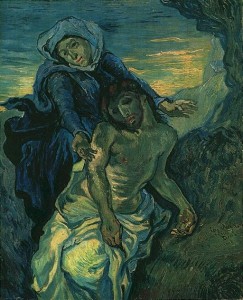Vincent van Gogh was born into a clan that were adept at two things – religion and art. Traditionally, the male members of the family were expected to enter the art world or follow a calling into religious ministry.
Vincent’s paternal grandfather, also named Vincent, obtained a degree of theology, and his paternal uncle, again also named Vincent, but called Uncle Cent, was an art dealer. Two of Vincent’s other uncles were also art dealers. Vincent’s grandfather’s uncle, once again also named Vincent, was a well-known artist and sculptor. Vincent’s father was a minister of the Dutch Reformed Church. Vincent’s maternal grandfather was a bookseller, which likely meshed well with Vincent’s quiet nature and love of study.
At 13, in 1866, Vincent left Jan Provily’s boarding school and was enrolled at Willem II College in Tilburg where he was instructed by Constantijn C. Huysmans (also spelled Huijsmans) encouraged Vincent’s artistic talent. He left the school a year later. Although it is unclear why exactly Vincent left Willem II, it is said that the family’s financial situation could no longer support the cost of the school and Vincent was forced to gain employment.
It was religion that dominated Vincent’s early years, not art. Although Vincent began sketching before he even entered school and clearly had a great deal of talent, his work was more technical than emotional – he copied more than he created – and it lacked the intensity of his later work. In fact, it is said that his religious beliefs were so rigid that they eventually clashed with the art world into which he was inducted at birth.
After he left Willem II College, Vincent’s Uncle Cent secured a position for him in his art dealership, Goupil & Cie., in The Hague, where Vincent was to be trained as a clerk. Transferring to a position at Messr’s Goupil & Co., in London in June of 1873, Vincent, at the age of 20, was so successful that his income outstripped that of his own father.
It appears that sometime during the years of 1873-1875, Vincent’s mental health began to change. Although his letters to his brother, Theo, indicate that he was happy and successful, the demise of his first serious relationship may have been the spark that led him into the madness that was known to rule his later years. However, it must be noted that, even at this early stage in his life, Vincent did admit to bouts of depression. In a letter to his brother, Theo, in March of 1873, Vincent admitted to occasional suicidal thoughts.
Upon his move to London, Vincent fell in love with his landlady’s daughter, Eugenie Loyer. In 1874, even after finding out that she was engaged, Vincent proposed to Loyer. Vincent was not only miserable, he was distraught. It is said that, after Loyer’s rejection, Vincent stopped caring for himself, presenting an image that was shabby, temperamental, and apathetic – an image that did not please his employers. It is also said that, at this time, Vincent became obsessed with religion and that his beliefs now clashed with the art world.
Although it is said that Vincent began to tell art customers to not waste their money on the art that his firm was selling because his religious beliefs led him to promote art as a worthless pursuit, it is also said that his blatant anger toward his customers was born of the belief that they treated art as a commodity rather than the expression of life that he believed it was. Regardless of the reason for his obvious distress toward his employment, Vincent was fired from his position with Goupil & Co. on April 1, 1876, and was now displaying behavior indicative of the illnesses that would plague him from then on.

